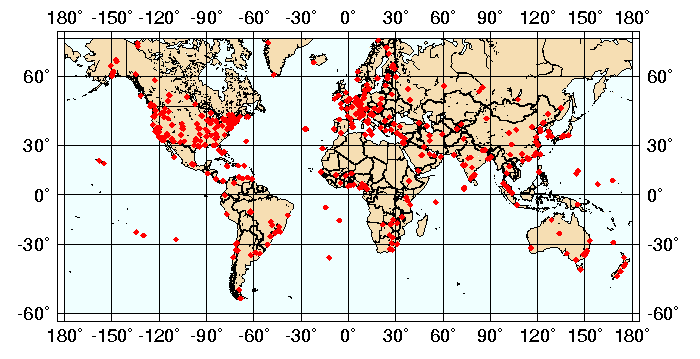
Global background ozone levels are not well documented as few ozone measurements have been made in many parts of the world. In an effort to bridge this information gap, a global-scale ozone air monitoring network was designed based on the use of ozone passive air monitoring devices. Volunteers at more than 400 locations around the world assisted us with this two part study in March and August, 1999.

It's easy to become confused about the "ozone problem." We are asked to stop producing ozone because it is unhealthy and causes damage to plants and materials. At the same time we are told to worry about the earth's ozone layer being depleted. The "good ozone" is found in the stratosphere (the part of the atmosphere far above the earth's surface) where it shields us from the sun's ultraviolet rays. This "good ozone" is being destroyed by chlorofluorocarbons and other gases being released into the atmosphere.
Our global ozone study is looking at the "bad ozone" found at ground-level in the troposphere (the part of the atmosphere closest to the earth's surface). Ground-level ozone is a primary contributor to smog. Ground level ozone is a secondary air pollutant created when sunlight reacts with other pollutants such as hydrocarbons and oxides of nitrogen (NOx). Primary pollutants come from a variety of sources including emissions from automobiles, lawn mowers, and other machines, combustion (burning refuse, for example), volatilization of solvents from painting, dry cleaning, and many other activities.
Ozone is a highly reactive chemical. It can irritate the lungs causing respiratory ailments. Ozone can affect plants, impacting forests and damaging food crops. Ozone also damages materials causing textiles to weaken, rubber to deteriorate, dyes to fade, and paint to crack. Although, ozone is thought to be primarily a problem of large cities like Los Angeles, it is found all over the world, and often has higher concentrations in remote or rural regions where other pollutants that might react with ozone (thus reducing it) are not present.
Recently, the U.S. Environmental Protection Agency set a new ozone ambient air quality standard at 0.08 ppm O3 not to be exceeded over 8-hour averaging times. The new air quality standard is low enough that global background ozone levels can make a substantial contribution to whether or not the standard is exceeded in some locations.
Our ozone passive monitor is housed in a thin plastic enclosure about the size of the radiation badges worn by x-ray technicians. The front of the small plastic enclosure consists of a porous Teflon wind screen through which ambient ozone diffuses. The ozone diffuses across an air gap inside the sampler and then encounters a chemically treated detection layer with which the ozone reacts.
The ozone sampler chosen for this experiment utilizes a compound (Indigo Carmine dye) that reacts with ozone producing a color change that is proportional to the ozone concentration to which the sampler is exposed times the duration of exposure. On a Diano Matchscan spectrophotometer we measure the color of each ozone detection layer, which consists of a paper dyed with Indigo Carmine, before we place it into the plastic sampler body. After use of the sampler, we measure the amount by which the color has changed, which tells us the average ozone concentration to which each sampler was exposed at its particular location.
Our monitoring network was based on the concept that interested individuals around the world are willing to cooperate to the extent of placing a simple passive ozone sampler outdoors at their site for approximately one month and then would mail it back to us in California for analysis. One goal was to make this as easy as possible. The sampler itself is very small (approx. 4 X 5 X 1 cm) and required only to be taken out of a sealed plastic bag, hung outside for one month, retrieved and returned to us. It was designed to be small enough to fit in an inconspicuous padded envelope for mailing.
We conducted experiments world-wide during two test periods, one in winter and one in summer, with the first set of passive monitors deployed during March, 1999 and the second set deployed during August, 1999. March represents the end of the winter in the northern hemisphere, a period of possible stratospheric ozone intrusion, as well as the end of the summer photochemical smog season in the southern hemisphere.
During the March experiment, ozone samplers were mailed to 542 sites in 122 countries. Approximately 80% of the samplers deployed were returned to us. Only 8 packages are known to have been ``lost-in-the-mail''. A few other samplers were lost due to forces beyond our control (e.g., buried when a snow drift reached more than 6 feet depth above ground and submerged the sampler). At least one sampler was reported eaten by a squirrel, and another sampler was sold by mistake at a garage sale. One sampler placed too close to a barbecue melted, and sadly, two samplers were lost due to war in the Balkans. But beyond these unusual occurrences, the overwhelming majority of the sampling sites functioned as planned for the entire one-month period of the study.
Our preliminary results indicate that some of the highest ozone levels measured in March world-wide occurred in Scandinavia. This agrees with measurements taken in Finland and Sweden in the early 1990's, which exhibited peak ozone levels in March. The high ozone concentrations are probably caused by stratospheric ozone down-mixing at that time of year; it's too cold and dark that far north at that time of year for much else. Some of the lower ozone levels appear to be in such varied locales as Ouagadougou, Burkina Faso; Khabarovsk, Russia; Las Vegas (NV), USA; and La Serena, Chile. Preliminary data from the August experiment show much higher ozone levels at many locations around the world.
View preliminary data.
Brought to you by the Global Ozone Monitoring Team: